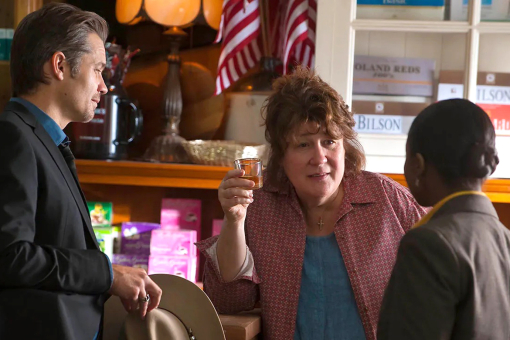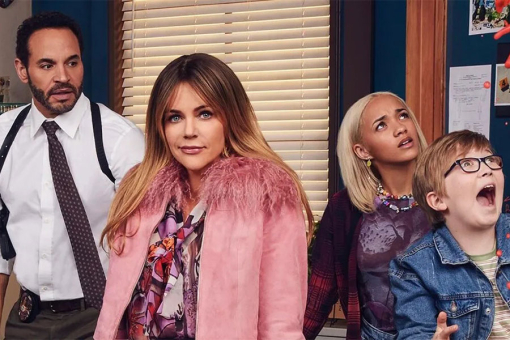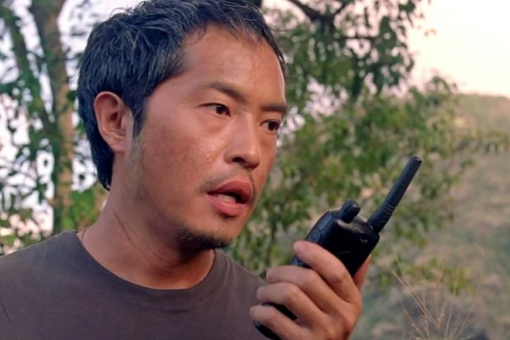“There was a 48-hour period where we were dead.”
That two-day window in early 2004 that Lost cocreator and coshowrunner Damon Lindelof speaks of is all that separated ABC’s popular sci-fi drama from active greenlight to another casualty of development hell.
It’s fitting that a show about fate had its own changed once a new network regime discovered there was potential worth exploring in a serialized show that mixed Twilight Zone–esque “mystery box” plots with character-first action. Lost centered on the survivors of Oceanic Flight 815, inbound for Los Angeles from Sydney when their plane crashed on a mysterious island with supernatural tendencies — a place home to the Others, the Hatch and, of course, the Smoke Monster.
But 20 years ago, on September 22, 2004, the island was just a place strewn with jet wreckage and second chances. Where a few of those survivors — like dogged spinal surgeon Jack (Matthew Fox), fugitive Kate (Evangeline Lilly), naive but likable Hurley (Jorge Garcia) and estranged spouses Sun (Yunjin Kim) and Jin (Daniel Dae Kim) — could rediscover themselves in their attempt to repair what the crash threatened to tear apart. As crazy as events and plots could get on the show, Lost’s “constant” was its characters — something Lindelof reiterated when he spoke with the Television Academy for an exclusive interview celebrating the popular series’ 20th anniversary.
Below, the executive producer reveals how he and J.J. Abrams came up with the spine of the series following a general meeting, and he reminisces on key scenes from the pilot and what led to the show ultimately being given a second chance.
Television Academy: Do you remember where you were when you first saw the final cut of the two-hour pilot episode?
Damon Lindelof: Yeah, it would have been in the editing bay with [editor] Mary Jo [Markey], on the Disney lot. I will never intentionally present a mistruth, but memory is very subjective. If anything I say contradicts someone else, I would go with their version. Because the editing process of the pilot was so rushed — that is to say, we wrapped around April 25, [2004], I think, in Hawaii, and then we delivered a two-hour cut of the pilot with pieces of [Michael] Giacchino's score and temporary viz effects. I feel like [that cut] was delivered about 10 days later. But Mary Jo was cutting, obviously, while we were shooting, and J.J. was already giving notes.
But the first time we sat and watched an entire cut of the show, start to finish, was maybe two days after we got back from L.A. She had assembled something. I remember J.J., myself, [producer] Bryan Burk, Mary Jo and maybe [executive producer] Sarah Kaplan was there as well, watching it. I was proud of what we had done. I think the prevailing sentiment – and I do have my journal entries to verify my thoughts on the time – was that they were never going to pick it up.
Really? Why did you think that at the time? Because ABC wasn’t really in the “genre TV” business then?
I think that's one of the reasons. There was also a political upheaval while we were shooting the pilot, where [chairman of ABC Entertainment Group, 2001–04] Lloyd Braun, who basically threw himself in front of a speeding train in order to get this thing made, had left ABC and was replaced by Steve McPherson, who had been the head of Touchstone. So there was some continuity. Even though [Steve] was actually one of the people who gave the note that you can't kill Jack in the original pilot.
But I think Steve was kind of forced to make the show. I think from a studio perspective — the expense of the show, the impracticality of shooting in Hawaii, the serialized and mythological and genre nature of it all — there were just so many reasons for them to say no. It was just so much easier to say no than it was for them to say yes. So I just wanted to be a pragmatist about it. And they called us and told us that it wasn't.
How did that call go? Was any of their rationale what you were considering at the time?
After they screened the pilot, they were like, “It's really great, and we can't do it.” It was for all the reasons I just said. And then I was interviewing for other jobs and starting to feel a little bit sad about [it] — I was like, “Maybe I did want to do more.”
And then they tested the pilot, and it tested very well, and they reevaluated their position. So there was a 48-hour period where we were dead. And then we got a call on Friday afternoon that we needed to be in New York on Monday for the Upfronts.
Since you mentioned Lloyd Braun, do you know how he ended up being the voice that did the “Previously on Lost” voiceover?
I remember it being Bryan Burk's idea, and all of us felt that we needed to honor Lloyd for his incredible contribution, and this would be a really cool way to do it. I remember Bryan pitching it, maybe as a joke, but all of us were just like, “Yes.”
What was your writing process like with J.J.?
Very atypical. I've never done anything like it before. I mean, obviously I'd worked in television. And the way that television traditionally works, particularly if you are a lower-level writer — which I was on Nash Bridges [CBS], and then when I was on Crossing Jordan [NBC] — is that you do a draft and then you turn it in to the showrunner, and the showrunner notes you and then you do another draft. Then the showrunner takes it and does their rewrite or polish or whatever. And then that's the final final [draft]. But I never had a writing partner. I'd never written a script with someone else.
And I think the first atypical part of writing the outline was because J.J. had the full-time job of showrunning Alias. I was doing passes on outline sequences and I would send them off to him, and then he would send it back to me fixed and also in his voice. And I had read Alias and Felicity scripts, again, because I'm a writer and I was a fan. So I was like, “I know what J.J.'s style is, but I can't really copy it because it'll feel like pandering, and also, it will feel unnatural. So I'll write it the way that I would.” But I did so with the understanding that I no longer have to fit inside the box of a pre-existing show that I didn't create, which is what my experience was. So I was kind of finding my own voice while also trying to write in a way that felt consistent with what I perceived to be his voice.
And my writing style, my natural writing style, is that I'm a bit overly descriptive in the scene description — in order to communicate to the actors and the director what the tone of the thing is, and also, I want it to be an entertaining read. And then J.J. writes that way, too. So the outline suddenly existed, and it felt like we had both written it, obviously, with story input from Bryan and [then-Alias writers] Jesse Alexander and Jeff Pinkner, but the [bulk of] writing was J.J. and I. But [the outline] was the first thing we wrote together. And then once the show got picked up, J.J. was like, “Okay, well, now we have to just start writing scenes in order to cast actors. Because we need to start casting people before there's a script.” And so some of those scenes that we wrote, I would write one or he would write one.
One of the pilot’s most memorable and often quoted scenes is the “count to five” scene between Jack and Kate.
That scene was going to be sides for [actors auditioning for] Jack and Kate. I think J.J. just basically wrote that scene. In my memory, he just wrote it. He had told the story about how he knew a spinal surgeon who talked about the [nerve endings like] angel hair pasta, and my recollection is that that scene was just all him. And then we wrote additional Kate sides.
In the outline, Kate was not yet the fugitive. Her backstory was more similar to what Rose and Bernard's backstory would end up being, in that her fiancé was in the tail section, but they had just kind of had a bad fight prior to getting on the plane in Sydney. And she was about to end the relationship when the crash happened. And somewhere in between turning in the outline and beginning to manifest the script, we started to fall in love with the fugitive idea. And then Kate became a fugitive.
So when Evangeline was shooting that scene, did she not know then that her character was —
No, she knew. This is all the difference between the outline and the script. There was no draft of the script for at least two weeks between the outline getting picked up because all we were writing were sides for actors. Then we started rebreaking the story and changing things around, including Jack’s fate — because in the outline that got picked up, Jack gets killed halfway through the outline. And we were getting notes on the outline about when the monster might appear.
How else did the script change from the original outline? What were some other notable differences?
The original outline basically ends with the return of the group who has gone off to high ground to try to radio for help. They return to see that everybody else from the plane has vanished. And so there's only those 12 characters. There's also no polar bear in the outline. It's a wild boar.
So the evolution of the script was a little bit more improv comedy, where you're just trying things and stitching them together. And Jack is suddenly alive again, and then Kate is suddenly the fugitive. And then Yunjin came in and read for Kate, and we were like, “Who is that? Like, oh my god, this woman speaks perfect, fluent Korean. She was raised in Seoul, she's a huge celebrity in Korea, and maybe she should be a character on the show in and of herself.” Because, in the outline, there had been an elderly Japanese couple that felt very alienated from the rest of the castaways because they didn't speak any English. It was like, “Maybe they should be younger. Maybe Yunjin should be one of them.” Now, we've actually got to cast her husband — because they're not going to be background characters anymore but main characters. So, suddenly, Sun and Jin were in there. It was like we were having ideas as we would walk out of a casting session.
And a casting session is how you landed on Jorge Garcia for the fan-favorite character, Hurley.
Infamously, we'd watched an episode of Curb Your Enthusiasm, and the next morning J.J. was like, “Okay, there's this guy [in Curb], Jorge, that should be in Lost." And then it was like, “Well, who should he be?” There's a character named Hurley in the outline, but he's nothing like the Hurley that we all know and love — so we just wrote that.
I think Jorge came in and read Sawyer sides, just because we didn't have Hurley sides, because the character didn't exist in that form. But he was so funny. Then, suddenly, he's there. And so it was just completely and totally a month of chaos before there was a draft resembling the thing that you have read and that got shown.
How did the two of you land on the opening of Jack waking up on the beach to him racing between plane crash survivors, performing triage? Did that come out of your original meeting with J.J.?
I came into that meeting with two strong instincts. The first was that we had to solve for the audience's restlessness that the characters would never get off the island. And the way that we could potentially remedy that restlessness was that we get off the island in every episode by showing flashbacks of who they were before the crash. And those flashbacks would only be compelling if they were revealing something that the character was hiding on the island. So this idea of being able to have a blank slate and reinvent yourself and leave your past behind could be a critical sort of emotional thematic idea, because you kind of can't leave yourself behind. But I think we all crave an opportunity to start over. And maybe that's why the crash on an island – for some of our characters and audience — is a fantasy and not a nightmare. And so that’s where the flashbacks idea came from.
Then the second thing that I came in with was that the show should be subjective. And instead of starting it in the way we might expect, which is on the plane and then do the crash, I thought it would be interesting to be completely disoriented and start in the jungle with one of the characters waking up. I think I pitched that the dog came out and licked [Jack’s] face or something like that. The mini alcohol bottle was an add by J.J. later. But I was like, “We could follow that guy out to the crash, and that would immediately hook us in.” We'd know nothing about him. He hasn't spoken a word, and then he just runs into the fray. It's the idea that this is a character who doesn't run away from the danger — he runs into the danger, and he's a doctor. We get all the benefits of it being a medical show, because he's administering first aid. And so he's an action hero and doctor at the same time. That was my pitch.
I think a lot of the elements of the opening, particularly [the idea] that the plane itself is still dangerous — the turbine, the falling wing — that was all J.J. As he was pitching [something like], “Yeah, it would be amazing if this guy gets sucked into the turbine engine,” I was like, “How are we going to do that?” He was like, “Don't worry about it. We didn't pitch them this show. They're desperate to do it. So we might as well go all the way.” I think his audaciousness, creatively — it always felt like we could really have a lot of fun with this very unique opportunity where we didn't have to sell them. They already wanted to do this thing. And we could use that as a way of really pushing the envelope and boundaries of what people perceived was a network television show.
But I'm sitting there in the presence of someone who I worship, and he's just talking to me like we're partners now. And I had to constantly just sort of like — I was outside of my body going, “Do you see what's happening here?” I was like, “Come back into my body. We need to just fucking make this thing. You can't just sit around and be starstruck. You have to pretend like you belong here, and we'll talk later about how exciting it is.”
Later, when sitting around a campfire, Jack uses a tree leaf in the shape of the plane to deliver some critical exposition regarding the crash. That is a very effective way to get that info out visually. Do you recall who came up with that?
I definitely remember that idea coming from J.J., but I can't remember when, or how early into the draft, it came.
The ending of the pilot — with Charlie’s final line of “Guys, where are we?” — really hooks audiences in to tune in for the next episode. Can you talk about how you and J.J. shaped that scene?
My memory is that I pitched that we should end the pilot with a question, because this show was going to be very mystery-centered. And why not? We wanted the characters, without breaking the fourth wall, to basically articulate what people who are watching the show were feeling, too. I think I pitched “Where are we?” as the final line, and J.J. added the “guys.” And obviously I think Dom — his delivery there was exquisite. But that was always how [the pilot] ended. That's how it was scripted, to end on that line. There was a lot of back and forth about exactly what Rousseau's message said and what Shannon was effectively able to translate, but I don't think the last line of the thing ever changed once there was a draft.
This interview has been edited for length and clarity.
Lost is now streaming on Netflix.











